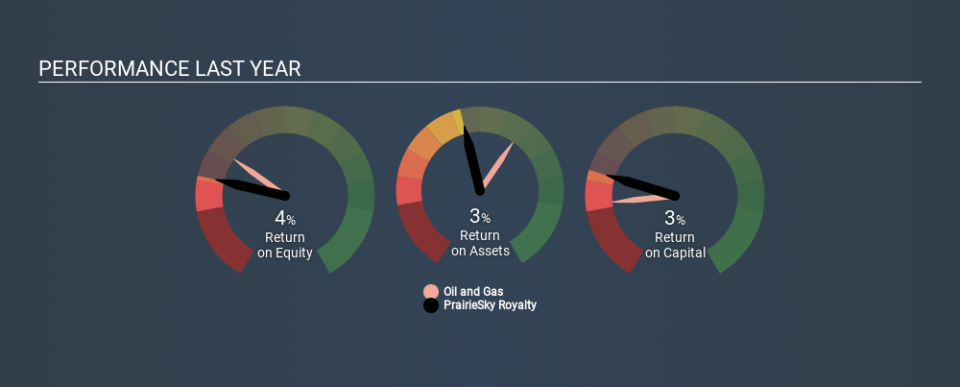Examining PrairieSky Royalty Ltd.’s (TSE:PSK) Weak Return On Capital Employed

Today we'll look at PrairieSky Royalty Ltd. (TSE:PSK) and reflect on its potential as an investment. Specifically, we're going to calculate its Return On Capital Employed (ROCE), in the hopes of getting some insight into the business.
Firstly, we'll go over how we calculate ROCE. Next, we'll compare it to others in its industry. Finally, we'll look at how its current liabilities affect its ROCE.
Return On Capital Employed (ROCE): What is it?
ROCE measures the 'return' (pre-tax profit) a company generates from capital employed in its business. All else being equal, a better business will have a higher ROCE. Ultimately, it is a useful but imperfect metric. Author Edwin Whiting says to be careful when comparing the ROCE of different businesses, since 'No two businesses are exactly alike.
So, How Do We Calculate ROCE?
Analysts use this formula to calculate return on capital employed:
Return on Capital Employed = Earnings Before Interest and Tax (EBIT) ÷ (Total Assets - Current Liabilities)
Or for PrairieSky Royalty:
0.032 = CA$87m ÷ (CA$2.7b - CA$38m) (Based on the trailing twelve months to September 2019.)
So, PrairieSky Royalty has an ROCE of 3.2%.
See our latest analysis for PrairieSky Royalty
Does PrairieSky Royalty Have A Good ROCE?
ROCE can be useful when making comparisons, such as between similar companies. Using our data, PrairieSky Royalty's ROCE appears to be significantly below the 5.4% average in the Oil and Gas industry. This performance could be negative if sustained, as it suggests the business may underperform its industry. Putting aside PrairieSky Royalty's performance relative to its industry, its ROCE in absolute terms is poor - considering the risk of owning stocks compared to government bonds. It is likely that there are more attractive prospects out there.
We can see that, PrairieSky Royalty currently has an ROCE of 3.2% compared to its ROCE 3 years ago, which was 0.5%. This makes us wonder if the company is improving. You can click on the image below to see (in greater detail) how PrairieSky Royalty's past growth compares to other companies.
When considering this metric, keep in mind that it is backwards looking, and not necessarily predictive. ROCE can be misleading for companies in cyclical industries, with returns looking impressive during the boom times, but very weak during the busts. ROCE is only a point-in-time measure. Remember that most companies like PrairieSky Royalty are cyclical businesses. Since the future is so important for investors, you should check out our free report on analyst forecasts for PrairieSky Royalty.
What Are Current Liabilities, And How Do They Affect PrairieSky Royalty's ROCE?
Current liabilities are short term bills and invoices that need to be paid in 12 months or less. Due to the way ROCE is calculated, a high level of current liabilities makes a company look as though it has less capital employed, and thus can (sometimes unfairly) boost the ROCE. To counteract this, we check if a company has high current liabilities, relative to its total assets.
PrairieSky Royalty has total liabilities of CA$38m and total assets of CA$2.7b. As a result, its current liabilities are equal to approximately 1.4% of its total assets. PrairieSky Royalty has very few current liabilities, which have a minimal effect on its already low ROCE.
Our Take On PrairieSky Royalty's ROCE
Still, investors could probably find more attractive prospects with better performance out there. But note: make sure you look for a great company, not just the first idea you come across. So take a peek at this free list of interesting companies with strong recent earnings growth (and a P/E ratio below 20).
There are plenty of other companies that have insiders buying up shares. You probably do not want to miss this free list of growing companies that insiders are buying.
If you spot an error that warrants correction, please contact the editor at editorial-team@simplywallst.com. This article by Simply Wall St is general in nature. It does not constitute a recommendation to buy or sell any stock, and does not take account of your objectives, or your financial situation. Simply Wall St has no position in the stocks mentioned.
We aim to bring you long-term focused research analysis driven by fundamental data. Note that our analysis may not factor in the latest price-sensitive company announcements or qualitative material. Thank you for reading.

 Yahoo Finance
Yahoo Finance 
